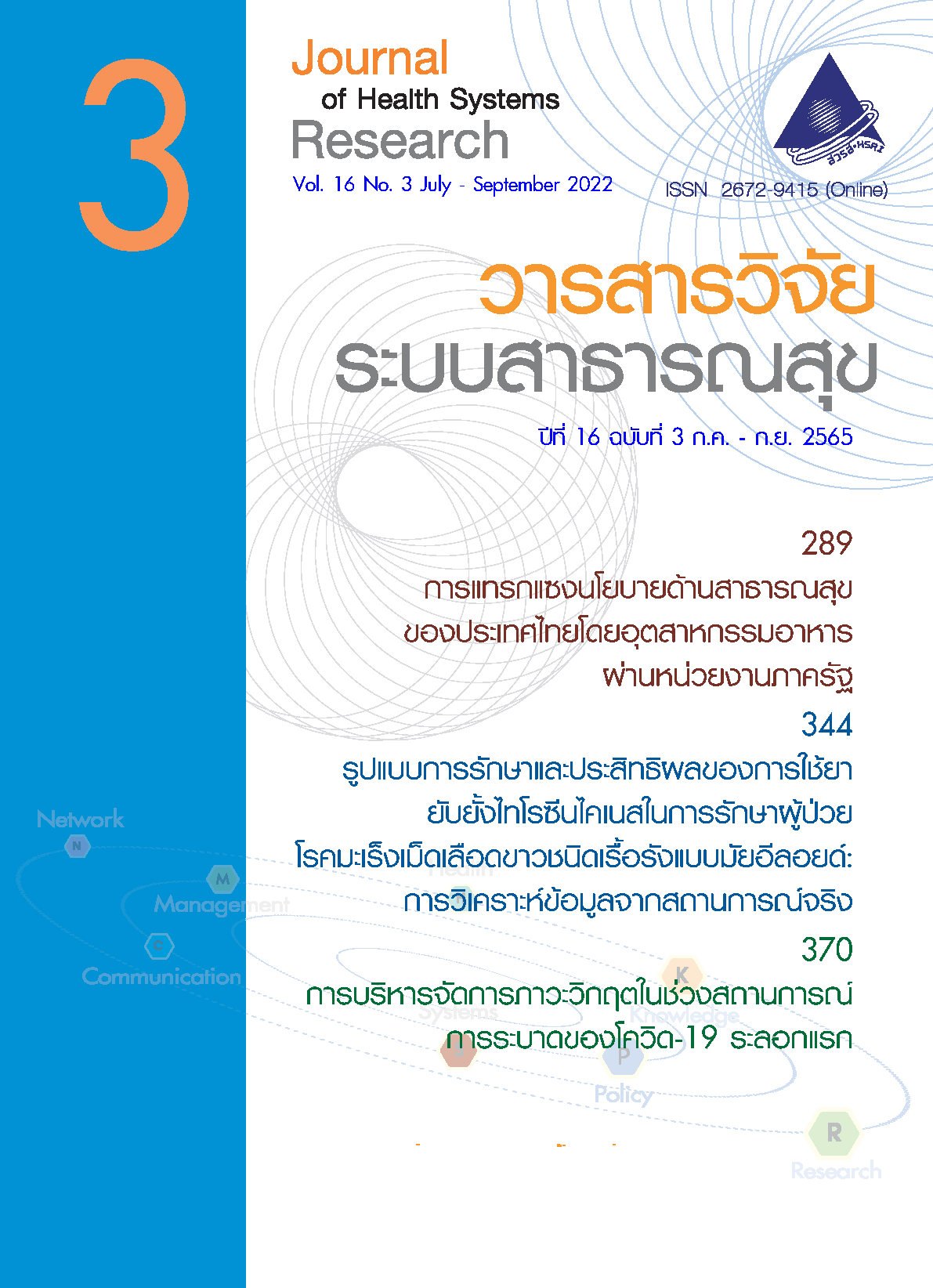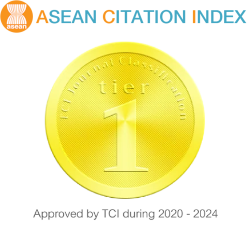การส่งเสริมกิจกรรมทางกายในระดับสิ่งแวดล้อมและนโยบายในประเทศไทย: การทบทวนเชิงวิเคราะห์
คำสำคัญ:
กิจกรรมทางกาย, สิ่งแวดล้อม, นโยบาย, ประเทศไทย, การทบทวนวรรณกรรมบทคัดย่อ
การมีกิจกรรมทางกายที่เพิ่มขึ้นก่อให้เกิดประโยชน์อย่างมาก โดยไม่เพียงลดการเสียชีวิตก่อนวัยอันควรและลดค่าใช้จ่ายในการรักษาพยาบาลจากโรคไม่ติดต่อ แต่ยังส่งผลต่อการสร้างสังคมที่เข้มแข็ง ลดความเหลื่อมล้ำในสังคมและเพิ่มคุณภาพชีวิต การส่งเสริมการมีกิจกรรมทางกายในระดับสิ่งแวดล้อมและนโยบายถือเป็นแนวทางในการเพิ่มกิจกรรมทางกายในระดับประชากรที่มีศักยภาพ อย่างไรก็ตาม งานวิจัยดังกล่าวยังมีจำกัด โดยเฉพาะในกลุ่มประเทศที่มีรายได้ต่ำและปานกลาง การศึกษานี้ มีวัตถุประสงค์เพื่อประเมินการส่งเสริมกิจกรรมทางกายในระดับสิ่งแวดล้อมและนโยบาย เพื่อเป็นแนวทางในการพัฒนาการส่งเสริมกิจกรรมทางกายในประเทศไทย ด้วยการทบทวนวรรณกรรมอย่างเป็นระบบจากฐานข้อมูล ได้แก่ PubMed, Scopus, Web of Science รวมถึงฐานข้อมูลในประเทศ และแผนพัฒนาองค์การบริหารส่วนจังหวัด 77 จังหวัด โดยใช้การทบทวนวรรณกรรมเชิงวิเคราะห์ โดยคัดเลือกเหลือ 11 การศึกษามาวิเคราะห์จาก 1,681 การศึกษา ผลการศึกษาพบว่า หลักฐานเชิงประจักษ์เรื่องการส่งเสริมกิจกรรมทางกายด้านสิ่งแวดล้อมและนโยบายในประเทศไทยยังมีข้อจำกัดในด้านจำนวนและความหลากหลาย โดยการส่งเสริมมุ่งเน้นที่การสนับสนุนสถานที่เพื่อเล่นกีฬามากกว่าเพื่อกิจกรรมทางกาย ประชากรวัยผู้ใหญ่ให้ความสำคัญการส่งเสริมโครงสร้างพื้นฐานและการผังเมือง ในขณะที่ผู้สูงอายุให้ความสำคัญกับสถานที่สำหรับกิจกรรมนันทนาการในระดับพื้นที่ พบว่า 9 จาก 77 จังหวัดสนับสนุนการสร้างทางจักรยาน 16 จังหวัดสนับสนุนการสร้างพื้นที่สีเขียว ในขณะที่ 42 จังหวัดสนับสนุนสถานที่เล่นกีฬา การสื่อสารและสนับสนุนการนำนโยบายส่งเสริมกิจกรรมทางกายไปปฏิบัติในพื้นที่ กลไกการสร้างความร่วมมือระหว่างกระทรวงสาธารณสุขและกระทรวงมหาดไทย การสื่อสารสาธารณะและการประเมินนโยบายอย่างต่อเนื่อง เหล่านี้เป็นประเด็นที่ควรให้ความสำคัญ รวมถึงการศึกษาในอนาคตควรมุ่งเน้นเรื่องการประเมินนโยบายส่งเสริมกิจกรรมทางกายในแต่ละกลุ่มวัยด้วย
เอกสารอ้างอิง
Ding D, Lawson KD, Kolbe-Alexander TL, Finkelstein EA, Katzmarzyk PT, van Mechelen W, et al. The economic burden of physical inactivity: a global analysis of major noncommunicable diseases. Lancet. 2016;388(10051):1311-24.
World Health Organization. Global status report on noncommunicable diseases 2014. Geneva: World Health Organization; 2014.
Katzmarzyk PT, Friedenreich C, Shiroma EJ, Lee IM. Physical inactivity and non-communicable disease burden in low-in-come, middle-income and high-income countries. Br J Sports Med. 2022;56(2):101-6.
Lee IM, Shiroma EJ, Lobelo F, Puska P, Blair SN, Katzmarzyk PT, et al. Effect of physical inactivity on major non-communicable diseases worldwide: an analysis of burden of disease and life expectancy. Lancet. 2012;380(9838):219-29.
Guthold R, Stevens GA, Riley LM, Bull FC. Worldwide trends in insufficient physical activity from 2001 to 2016: a pooled analysis of 358 population-based surveys with 1.9 million participants. Lancet Glob Health. 2018;6(10):e1077-e86.
Jaramillo AM, Montes F, Sarmiento OL, Rios AP, Rosas LG, Hunter R, et al. Social cohesion emerging from a community-based physical activity program: a temporal network analysis. Netw Sci (Camb Univ Press). 2021;9(1):35-48.
Stearns JA, Godley J, Veugelers PJ, Ekwaru JP, Bastian K, Wu B, et al. Associations of friendship and children’s physical activity during and outside of school: a social network study. SSM Popul Health. 2019;7:008-8.
Division of Physical Activity and Health, Department of Health, Ministry of Public Health. 12 Local authority models on physical activity promotion. Nonthaburi: Informan Teem Computer; 2018.
World Health Organization. Global action plan on physical activity 2018-2030 Geneva: World Health Organization; 2018.
Sallis JF, Cervero RB, Ascher W, Henderson KA, Kraft MK, Kerr J. An ecological approach to creating active living communities. Annu Rev Public Health. 2006;27:297-322.
McCormack GR, Shiell A. In search of causality: a systematic review of the relationship between the built environment and physical activity among adults. Int J Behav Nutr Phys Act. 2011;8:125.
Sallis JF, Bull F, Burdett R, Frank LD, Griffiths P, Giles-Corti B, et al. Use of science to guide city planning policy and practice: how to achieve healthy and sustainable future cities. Lancet. 2016;388(10062):2936-47.
Sallis JF, Cerin E, Kerr J, Adams MA, Sugiyama T, Christiansen LB, et al. Built environment, physical activity, and obesity: findings from the International Physical Activity and Environment Network (IPEN) adult study. Annu Rev Public Health. 2020;41:119-39.
Carver A, Timperio A, Hesketh K, Crawford D. Are safety-related features of the road environment associated with smaller declines in physical activity among youth? Journal of Urban Health : Bulletin of the New York Academy of Medicine. 2010;87(1):29-43.
Dias AF, Gaya AR, Brand C, Pizarro AI, Fochesatto CF, Mendes TM, et al. Distance from home to the nearest park and the use of the parks for physical activity: the mediator role of road safety perception in adolescents. Public Health. 2019;168:9-16.
Ferrari G, Rezende LFM, Florindo AA, Mielke GI, Peres MFT. School environment and physical activity in adolescents from Sao Paulo city. Sci Rep. 2021;11(1):18118.
Thomson JL, Goodman MH, Landry AS. Assessment of neighborhood street characteristics related to physical activity in the Lower Mississippi Delta. Health Promot Perspect. 2019;9(1):24-30.
Division of Physical Activity and Health, Department of Health, Ministry of Public Health. Thailand physical activity strategy 2018-2030. Bangkok: NC Concept; 2018.
Khamput T, Patsorn K, Thongbo T, Seunglee S, Keryai T, Sangsamritpol W, et al. Administration of physical activity promotion by twelve local administrative organizations in Thailand. Journal of Health Systems Research. 2019;13(1):63-89.
The World Bank. Population, total - Thailand. Washington, D.C.: The World Bank; 2022 [cited 2022 Feb 25]. Available from: https://data.worldbank.org/indicator/SP.POP.TOTL?locations=TH.
Determining Plans and Process of Decentralization to Local Government Organization Act, B.E. 2542 (1999). (Nov 11, 1999). (in Thai)
Liangruenrom N, Topothai T, Topothai C, Suriyawongpaisan W, Limwattananon S, Limwattananon C, et al. Do Thai people meet recommended physical activity level?: The 2015 national health and welfare survey. Journal of Health Systems Research. 2017;11(2):205-20.
Division of Physical Activity and Health, Department of Health, Ministry of Public Health. Thailand action plan on physical activity 2018-2020. Bangkok: NC Concept; 2018.
Topothai T, Chandrasiri O, Liangruenrom N, Tangcharoensathien V. Renewing commitments to physical activity targets in Thailand. The Lancet. 2016;388(10051).
Topothai T, Suphanchaimat R, Tangcharoensathien V, Putthasri W, Sukaew T, Asawutmangkul U, et al. Daily step counts from the first Thailand National Steps Challenge in 2020: a cross-sectional study. Int J Environ Res Public Health. 2020;17(22):8433.
Liangruenrom N, Suttikasem K, Craike M, Bennie JA, Biddle SJH, Pedisic Z. Physical activity and sedentary behaviour research in Thailand: a systematic scoping review. BMC Public Health. 2018;18(1):733.
Dixon-Woods M, Cavers D, Agarwal S, Annandale E, Arthur A, Harvey J, et al. Conducting a critical interpretive synthesis of the literature on access to healthcare by vulnerable groups. BMC Med Res Methodol. 2006;6:35.
Hong QN. Mixed methods appraisal tool (MMAT) version 2018: User guide. 2018.
Tiraphat S, Peltzer K, Thamma-Aphiphol K, Suthisukon K. The role of age-friendly environments on quality of life among Thai older adults. Int J Environ Res Public Health. 2017;14(3).
Ruengtam P. Factor analysis of built environment design and management of residential communities for enhancing the wellbeing of elderly people. In: ing L, Fiorito FO, P., editors. International High-Performance Built Environment Conference - A Sustainable Built Environment Conference 2016 series (SBE16)2017. p. 966-74.
Tuangratananon T, Topothai T, Khamput T, Saengruang N, Kosiyaporn H, Kulthanmanusorn A, et al. Public policy and social determinants of health management at three levels of municipalities in Thailand. Journal of Health Systems Research. 2018;12(3):384-403.
Kongsri P. Enforcement the legal and policy for the pedestrian and bike lane safety and sustainable developed in Thailand by comparison between Thailand and Australia, developed country. Bangkok: The 5th Thailand Bike and Walk Forum: Walk and Bike Friendly Community; 2017. p.22-32.
Rutirako P. Bicycling and walking facilities survey in Hatyai city municipality, Hatyai district, Songkla province. Bangkok: The 5th Thailand Bike and Walk Forum: Walk and Bike Friendly Community; 2017. p. 62-9.
Chaysuk J, Wethyavivorn P. Students and staff’s perspectives toward the use of bicycles in Kasetsart University Bangkhen Campus. Bangkok: The 5th Thailand Bike and Walk Forum: Walk and Bike Friendly Community; 2017. p. 93-101.
Detphichai P, Phongathichart P. An interest and factors promoting a safe walk-to- and bike-to-skytrain commuting: Bangwa-Talingchan case study. Bangkok: The 5th Thailand Bike and Walk Forum: Walk and Bike Friendly Community; 2017. p. 93-101.
Chandrasiri O, Arifwidodo SD. Inequality in active public park: a case study of Benjakitti Park in Bangkok, Thailand. In: Seto K, Robinson D, Virji H, Kovacs Z, Zhai J, Sami N, et al., editors. Urban Transitions Conference 2017. p. 193-9.
Termkhunthod F. The right of pedestrians on the cities’s roads. Bangkok: The 5th Thailand Bike and Walk Forum: Walk and Bike Friendly Community; 2017. p. 22-32.
Kaewkluengklom R, Satiennam W, Jaensirisak S, Satiennam T. Influence of psychological factors on mode choice behaviours: case study of BRT in Khon Kaen City, Thailand. Transp Res Procedia. 2017;25:5072-82.
Pratt M, Sarmiento OL, Montes F, Ogilvie D, Marcus BH, Perez LG, et al. The implications of megatrends in information and communication technology and transportation for changes in global physical activity. Lancet. 2012;380(9838):282-93.
Beenackers MA, Kamphuis CB, Giskes K, Brug J, Kunst AE, Burdorf A, et al. Socioeconomic inequalities in occupational, leisure-time, and transport related physical activity among European adults: a systematic review. Int J Behav Nutr Phys Act. 2012;9:116.
Dill J, McNeil N, Broach J, Ma L. Bicycle boulevards and changes in physical activity and active transportation: findings from a natural experiment. Prev Med. 2014;69 Suppl 1:S74-8.
Gerike R, de Nazelle A, Nieuwenhuijsen M, Panis LI, Anaya E, Avila-Palencia I, et al. Physical activity through sustainable transport approaches (PASTA): a study protocol for a multicentre project. BMJ Open. 2016;6(1):e009924.
Cerin E, Nathan A, van Cauwenberg J, Barnett DW, Barnett A, Council on E, et al. The neighbourhood physical environment and active travel in older adults: a systematic review and meta-analysis. Int J Behav Nutr Phys Act. 2017;14(1):15.
Gotschi T, de Nazelle A, Brand C, Gerike R, Consortium P. Towards a comprehensive conceptual framework of active travel behavior: a review and synthesis of published frameworks. Curr Environ Health Rep. 2017;4(3):286-95.
Giles-Corti B, Vernez-Moudon A, Reis R, Turrell G, Dannenberg AL, Badland H, et al. City planning and population health: a global challenge. The Lancet. 2016;388(10062):2912-24.
Division of Physical Activity and Health, Department of Health, Ministry of Public Health. Thailand action plan on physical activity 2021-2022. Bangkok: TS Interprint; 2021.
Centers for Disease Control and Prevention. The CDC guide to strategies to increase physical activity in the community. Atlanta: Centers for Disease Control and Prevention, Services UDoHaH; 2011.
Cerin E, Barnett A, Zhang CJP, Lai PC, Sit CHP, Lee RSY. How urban densification shapes walking behaviours in older community dwellers: a cross-sectional analysis of potential pathways of influence. Int J Health Geogr. 2020;19(1):14.
Katewongsa P, Widyastari DA, Choolers P, Iamyaem W. ‘Does the community use the built environment?’ Assessing the utilization of healthy space model in bridging physical activity inequalities for the Thai population. Journal of Studies and Research in Human Geography. 2020;14(1):107-23.
Sreedhara M, Valentine Goins K, Frisard C, Rosal MC, Lemon SC. Stepping up active transportation in community health improvement plans: findings from a national probability survey of local health departments. J Phys Act Health. 2019;16(9):772-9.
Topothai T, Topothai C, Meepring A. Promoting walking and cycling in daily life: a case study of four communities in Thailand. Journal of Health Systems Research. 2021;15(3):294-309.
Division of Physical Activity and Health, Department of Health, Ministry of Public Health. Recommendation on physical activity promotion administration by local authorities. Nonthaburi: Informan Teem Computer; 2018.
Bull FC, Milton K, Kahlmeier S. National policy on physical activity: the development of a policy audit tool. J Phys Act Health. 2014;11(2):233-40.
Messing S, Forberger S, Woods C, Abu-Omar K, Gelius P. Policies to promote physical activity in Germany : an analysis based on a policy audit tool from the World Health Organization. Bundesgesundheitsblatt Gesundheitsforschung Gesundheitsschutz. 2022;65(1):107-15.
ดาวน์โหลด
เผยแพร่แล้ว
รูปแบบการอ้างอิง
ฉบับ
ประเภทบทความ
สัญญาอนุญาต
ลิขสิทธิ์ (c) 2025 วารสารวิจัยระบบสาธารณสุข

อนุญาตภายใต้เงื่อนไข Creative Commons Attribution-NonCommercial-NoDerivatives 4.0 International License.
วารสารวิจัยระบบสาธารณสุขอยู่ภายใต้การอนุญาต Creative Commons Attribution-NonCommercial-NoDerivatives 4.0 International (CC BY-NC-ND 4.0) เว้นแต่จะระบุไว้เป็นอย่างอื่น



